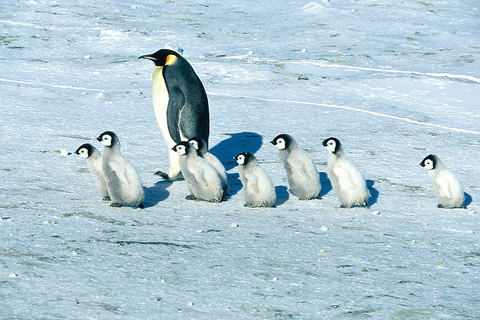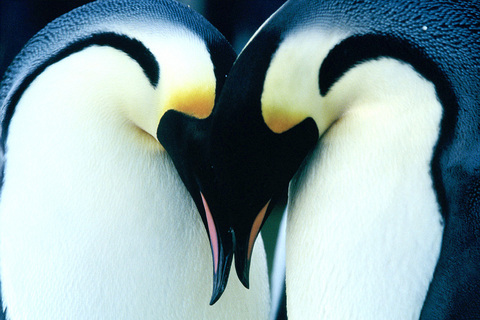Over the past month riders on Taipei's city buses have been bombarded with trailers of Luc Jacquet's film La Marche de l'Empreur (The Emperor's Journey). The trailer is heavy on shots of penguin chicks looking sleepy, clumsy, dopey and irresistibly cute.
As all successful marketers are aware, nothing draws a crowd like babies, and with the possible exception of tiger cubs or pandas, few animal species elicit coos in the same measure as penguin chicks. But the kids to whom this film is marketed will be in for a bit of a surprise when they watch the actual film.
Jacquet is a veteran of documentary who is familiar with the need for realism in shooting nature films, and in The Emperor's Journey he hasn't shied away from capturing the many predations that nature inflicts on penguins. The film begins with sweeping long shots of Antarctic landscapes that drive home the point that the intimidating, lonely environment will be as much a presence in the film as the penguins, which speak in sparing phrases through human narration.

PHOTOS COURTESY OF FLASH FORWARD
The journey alluded to in the title is the back-and-forth trips that penguin males and females are forced to undertake between the seashore and their nesting grounds while incubating their single egg and then feeding the chick. The trip from the shore to the nesting ground is about a 30-day waddle, which the penguins do in single file lines that stretch in Jacquet's stunning images from one horizon to the next.
The cycle followed by the penguins and film crew is straightforward enough. The penguins emerge from the sea, waddle to the nesting ground, mate, lay an egg, then the mother rushes back to the ocean to feed and returns with a massively bloated belly from which comes the food to feed the newborn chick that hatched under the father's watch. Once the mother returns, it's the father's turn to rush to the ocean to feed and return with a stomach full of goodies for junior so that he can grow and the whole family can make the final trek back to the ocean, where they will separate and never see each other again.
The completion of the cycle, however, is contingent on the penguin family overcoming the many dangers they will face, foremost of which is the freezing temperature hovering at around -40℃ during the incubation period. Jacquet offers plenty of shots of frozen eggs abandoned next to the huddle of penguins escaping the blasting wind and of penguins freezing to death. Male penguins, it turns out, are also extremely dim-witted creatures that break their own eggs when they walk or forget about the egg they're incubating and simply walk away for a minute only for it to freeze.

Once chicks hatch they face attack from jealous penguins who've lost their own chicks and from birds of prey. The mothers and fathers, meanwhile, are picked off in huge numbers by Mother Nature during their treks back and forth to the ocean. One shot of a hungry sea lion attacking penguins is certain to be nightmare material for many kids.
Softening the blow of the raw shots of penguins succumbing to unpleasant deaths is the narration, which in its sentimentality leaves the impression that the star protagonist family is not only loving and caring, but, most importantly, survives. This could have been a clever editing construction, however, since to the untrained eye penguins tend to look all the same.
Parents with kids in tow will be grateful that both penguin parents and their chick see it to the end of the film. Kids, on the other hand, might not have the attention span to actually see the end, as the film contains long stretches without narration and stunning panorama shots that hold for far longer that any shot in your typical kid flick. Without these arresting scenes, though, we wouldn't have the same appreciation of the beauty and the dangers ever present in Antarctica where the penguins, against all the odds, have survived.

This year will go down in the history books. Taiwan faces enormous turmoil and uncertainty in the coming months. Which political parties are in a good position to handle big changes? All of the main parties are beset with challenges. Taking stock, this column examined the Taiwan People’s Party (TPP) (“Huang Kuo-chang’s choking the life out of the TPP,” May 28, page 12), the Democratic Progressive Party (DPP) (“Challenges amid choppy waters for the DPP,” June 14, page 12) and the Chinese Nationalist Party (KMT) (“KMT struggles to seize opportunities as ‘interesting times’ loom,” June 20, page 11). Times like these can

June 23 to June 29 After capturing the walled city of Hsinchu on June 22, 1895, the Japanese hoped to quickly push south and seize control of Taiwan’s entire west coast — but their advance was stalled for more than a month. Not only did local Hakka fighters continue to cause them headaches, resistance forces even attempted to retake the city three times. “We had planned to occupy Anping (Tainan) and Takao (Kaohsiung) as soon as possible, but ever since we took Hsinchu, nearby bandits proclaiming to be ‘righteous people’ (義民) have been destroying train tracks and electrical cables, and gathering in villages

Dr. Y. Tony Yang, Associate Dean of Health Policy and Population Science at George Washington University, argued last week in a piece for the Taipei Times about former president Ma Ying-jeou (馬英九) leading a student delegation to the People’s Republic of China (PRC) that, “The real question is not whether Ma’s visit helps or hurts Taiwan — it is why Taiwan lacks a sophisticated, multi-track approach to one of the most complex geopolitical relationships in the world” (“Ma’s Visit, DPP’s Blind Spot,” June 18, page 8). Yang contends that the Democratic Progressive Party (DPP) has a blind spot: “By treating any

Swooping low over the banks of a Nile River tributary, an aid flight run by retired American military officers released a stream of food-stuffed sacks over a town emptied by fighting in South Sudan, a country wracked by conflict. Last week’s air drop was the latest in a controversial development — private contracting firms led by former US intelligence officers and military veterans delivering aid to some of the world’s deadliest conflict zones, in operations organized with governments that are combatants in the conflicts. The moves are roiling the global aid community, which warns of a more militarized, politicized and profit-seeking trend